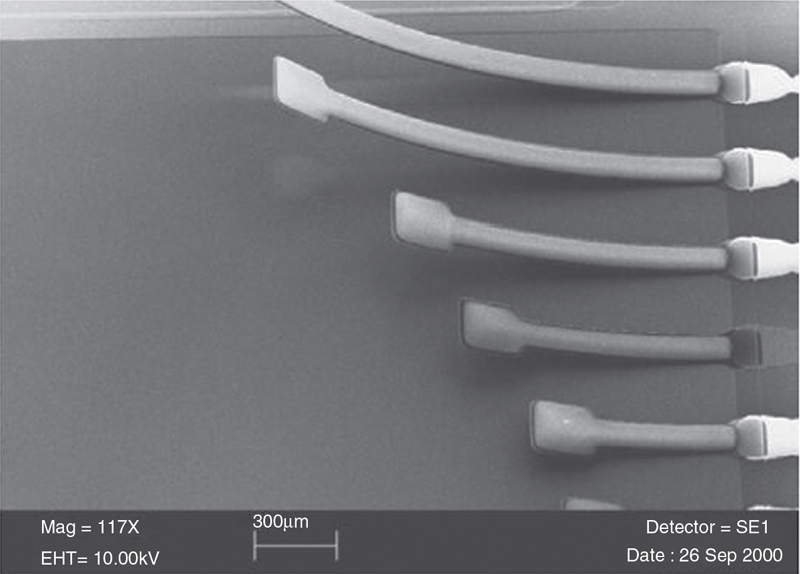Nanosensors
Abstract
Nanosensors are fundamental for the development and progress of research in nanotechnology. These devices have been receiving increasing attention because of the need for detecting and measuring, at the molecular level, chemical and physical properties of toxins, pollutants, and analytes in general. In this chapter, general concepts related to nanosensors as well as concepts related to atomic force microscopy (AFM) and atomic force spectroscopy (AFS) regarding the development of nanosensors and nanobiosensors will be introduced. Nanosensors employing AFM tips and (micro)cantilevers will be addressed with emphasis on theoretical concepts, their advantages and disadvantages, and main applications.
Keywords
5.1. Introduction
5.2. Sensors and Nanosensors: New Detection Tools

Table 5.1
Types of Current Nanosensors and Their Main Applications
| Types of Nanosensors | Main Applications |
| Gas nanosensors | Nonspecific sensors (global selectivity), in which the variation of electrical conductivity, voltage difference, or frequency as a function of its exposure to the monitored analyte is verified. For example, electronic nose systems to monitor the degree of ripeness of fruits and vegetables for harvest, as well as for quality control of food in general [7]. They are often used for recognizing specific chemical compounds in a complex mixture of fumes [8–12]. They may also serve as a portable breathalyzer for diagnosis of diseases [13]. |
| Enzyme nanobiosensors and nanosensors | In general, based on interdigitated sensors, AFM cantilevers or tips that are chemically functionalized to bond covalently to an enzyme or antibody [14–16]. Generally, their specific interactions are reversible, which permits the continuous monitoring of samples [17]. They are tools that are very useful for the diagnosis of diseases (in situ or not) and for other analytical purposes, such as the detection of toxic analytes in complex environments, because they are highly selective and sensitive [11,18]. |
| Fluorescent nanosensors (quantum dots) | The fluorescent properties of quantum dots are applied in procedures to detect tumors and chemical changes (intracellular) inside the body and to monitor important diseases in vivo, such as hyponatremia and diabetes [19–22]. They have potential applications in the fields of catalysis [20] and in the monitoring of the environmental quality of toxic substances [23]. |
| Chemical nanosensors | Sensors with biometric sensory receptors, usually constructed with molecularly imprinted polymers (MIP). They are useful for applications in industrial processes for control and automation, to monitor specific analytes and toxic substances in biomedical, pharmaceutical, and environmental analyses, and in the area of defense and security [24–26]. |
| Electric/ionic nanosensors | Sensors with electric/ionic detection, primarily field-effect transistors (FETs), offering simple and direct measurements in real time, as well as the characteristic of being portable [27,28]. Typically, these sensors use nanowires, nanoribbons, and nanotubes to measure the change in induced resistivity of a target molecule. Sensors of this nature using carbon nanotubes exhibit weaker detection limits compared to silicon nanowires; however, they are highly sensitive to the detection of deoxyribonucleic acid (DNA). The main limitation of electric/ionic nanosensors may be related to the inability to detect molecules of interest in physiological solutions, especially in those that have elevated concentrations of sodium, because these solutions may filter electric signals, thus reducing the detection sensitivity [6]. They have advantages such as nondestructive measurements of cells, allowing the constant monitoring of these analyses of various liquids and the detection of proteins, metal ions, various chemical species, and viral particles [6,29]. Recently, these sensors have also been used in research for the biomimicry of muscles and artificial heart valves [27]. |
| Magnetic nanosensors | These are sensors that use magnetic materials and the principles of magnetism to compose sensitive sensing systems. Many types use magnetic nanoparticles (diameter 5–300 nm) or magnetic particles (diameter 300–5000 nm), usually chemically functionalized to recognize specific molecular targets [30]. There are basically three types of magnetic biosensors that use different biosensing principles, magnetic materials, and instrumentation: magnetic relaxation switches, magnetic particle relaxation sensors, and magnetoresistive sensors [30,31]. In general, magnetic nanosensors are related to the detection of analytes such as nucleotides, proteins, viruses, cancerous cells, antibodies, and bacteria [30,32,33]. They also enable several industrial applications, such as the monitoring of processes, robotics, testing of magnetic fields for machines and motors, speed detection for transmissions, and position sensors for ferromagnetic structures and in the silent motor controls in hard drives. One of the major disadvantages of these sensors in technological applications is the need to operate at relatively low temperatures. |
| Optical nanosensors/pH nanosensors/Raman and hyper-Raman nanosensors | Optical nanosensors can be defined as sensing devices for chemical products or biological events using optical signals [34,35]. The sensors known as probes encapsulated by biologically localized embedding (PEBBLE) are also in this class. These nanosensors consist of an inert matrix in which a detection component and/or an optical correlator is entrapped [34]. Fluorescence is used as a transduction method because it is highly sensitive and relatively easy to measure. Optical nanosensors present advantages such as intracellular measurements with low or no physical disturbance [34], allowing the precise determination of oxygen changes in plant cells [36] as well as optical memory devices with high data density [37]. The pH nanosensors are based on optical fluorescence, making them excellent alternatives to methods involving glass electrodes. Their applications range from marine research to toxicological tests. They have advantages such as not requiring reference elements and being immune to electrical interference [38–41]. There are also optical nanosensors based on surface enhanced Raman scattering (SERS). These nanosensors based on SERS have been used in research involving various types of cells that present strong and specific Raman spectrum signals, such as macrophages, fibroblasts, and epithelial cells, and molecules in general [42–45]. |
| Optical fiber nanosensors | Optical fiber nanosensors are noted as an alternative to electronic nanosensors. They are of passive nature, presenting immunity to electromagnetic noise and having high durability [46]. Most optical fiber nanosensors are based on the modulation of the intensity of the light produced by the substance to be detected. The detection element can be any optical fiber or an external component attached to the fiber. In any case, one of the optical properties, such as color, index of refraction, or fluorescence must be modified as a function of the substance monitored in the environment [46,47]. |
| Twin-action nanosensors | This type of nanosensor is usually based on polymers whose physical–chemical surface properties respond to two different stimuli at the same time. As an example, there are sensors that can identify metal ions and their temperature via colorimetric response [48]. They have the advantage that their synthesis process is cheaper, compared to the synthesis of nanoparticles and quantum dots, in addition to the fact that they are extremely sensitive to external stimuli. |
| Graphene nanosensors/injectable | These are sensors of active or passive approach that usually transmit sensing data by wireless systems or by smartphone apps via fluorescence. The graphene is imprinted in tissue soluble in water (as adhesives) to be compatible with biological tissue, thus being able to offer an in situ monitoring of the level of bacterial infection and contamination [49]. Injectable nanosensors, in contrast, are more often used in the in situ monitoring of diseases such as diabetes and arterial hypertension. With them, it is possible to constantly measure glucose [50] and sodium [51] levels in blood, for example. Injectable nanosensors are similar to a tattoo and are implanted in patients in a minimally invasive form. These sensors have advantages such as being highly sensitive and allowing medical monitoring, even at a distance, thus ensuring the quality of life of the patient. |
5.3. Atomic Force Spectroscopy (Force Curve)

5.3.1. Theoretical Considerations Regarding Force Curves
5.3.1.1.. Basic AFS Principles

(A–B) The cantilever tip is induced to come into contact with the sample surface. (B–C) The tip reaches the C region because of attractive forces near the sample surface. (C–D) The cantilever bends up as the tip is pushed against the sample surface. (D–E) The cantilever comes into equilibrium with the sample surface forces. (E–F) The cantilever bends from attractive forces. (F–G) Rupture moment (F) bounded by tip interaction and sample surface. (G) The cantilever is restored to the initial position. Vertical distance (F–G) represents tip-sample force adhesion (Fadh), and in (G–H) the tip and sample are not in contact. Adapted from D.A. Smith, et al., Chemical force microscopy: applications in surface characterization of natural hydroxyapatite, Anal. Chim. Acta 479 (1) (2003) 39–57 [63]. Copyright (2014), with permission of Elsevier Publishing House.



(A) Surface covered with target analytes; (B) surface divided in pixels; and (C) adhesion map image generated by the adhesion force calculation of punctual force curves generated. The brightest pixels (white) represent the specific interaction, and the darkest pixels (gray) are those in which the adhesion force was low and there was therefore no specific interaction.
5.3.1.2. Theoretical Models for Analysis of Force Curves

 (5.1)
(5.1)
The profile of a spherical tip assumed using the Derjaguin–Muller–Toporov (DMT) theory is equal to the Hertz theory, in which F is the force applied, R is the sphere radius, y is the distance from the center of the contact area, δ is indentation depth, and ahertz and aJKR are the contact radius from the Hertz and JKR theories. Adapted from B. Cappella, G. Dietler, Force–distance curves by atomic force microscopy, Surf. Sci. Rep. 34 (1–3) (1999) 1–104 [68]. Copyright (2014), with permission of Elsevier Publishing House.
5.3.1.2.1. Hertz and Sneddon theory
 (5.3)
(5.3)
 (5.5)
(5.5)
 (5.6)
(5.6)
 (5.7)
(5.7)
 (5.8)
(5.8)
 (5.9)
(5.9)
 (5.10)
(5.10)
 (5.11)
(5.11)5.3.1.2.2.. Bradley, Derjaguin–Muller–Toporov, and Johnson–Kendall–Roberts theories
 (5.12)
(5.12)
 (5.14)
(5.14)
 (5.15)
(5.15)
 (5.16)
(5.16)
 (5.17)
(5.17)
 (5.18)
(5.18)
 (5.19)
(5.19)
 (5.20)
(5.20)
 (5.21)
(5.21)
 (5.22)
(5.22)5.3.2. Chemical Force Microscopy
5.3.2.1. Introduction
5.3.2.2. Methodology for the Functionalization and Characterization of AFM Probes

If the correct conformation is reached, the molecules will have spatial freedom to move; thus, they will reach the expected specific sensing active sites and will therefore achieve specific binding, and the adhesion force (Fadh) will be high (A). Otherwise, binding will not be specific, and the adhesion force will be low (B).

5.4. Applications for AFM Tip Sensors

(A) Schematic of the detection principle: enzyme molecules were immobilized on the AFM tip in solution as a result of electrostatic attraction. Enzyme-herbicide interaction was obtained through force curve measurements of the system. (B) Immobilized, oriented enzyme molecules over a functionalized AFM tip surface [58]. Reproduced from Franca et al., Designing an enzyme-based nanobiosensor using molecular modeling techniques, Phys. Chem. Chem. Phys. 13 (19) (2011) 8894–8899 [58]. With permission of the European Society for Photobiology, the European Photochemistry Association, and The Royal Society of Chemistry.
5.5. Microcantilever Sensors
5.5.1. Operation Modes of Microcantilever Sensors

 (5.30)
(5.30)
 (5.31)
(5.31)5.5.2. Theoretical Considerations

 (5.32)
(5.32)
 (5.34)
(5.34)5.5.3. Applications for Microcantilever Sensors

(A) System consisting of microcantilevers (one functionalized microcantilever while the others are without any covering) in PBS solution and (B) when a specific antigen is added in the solution, binding to the functionalized microcantilever and leading to deflection.

5.6. Challenges and Tendencies
List of Symbols
∆σ Surface tension induced by the analyte
∆m Change in mass
δ Deformation of the spherical tip
a Contact radius
a0 Contact radius with zero load
E Young’s modulus
F Force
fres Resonance frequency
fres(0) Initial resonance frequency
fres(1) Resonance frequency after mass is added
K Reduced Young’s modulus
K Spring constant
ks Spring constant of the sample
P Material’s density
P Pressure
R Sphere radius
ν Poisson’s ratio
W Work of adhesion upon contact
